
So this post is undeniably sad. What is even sadder is there may well be more of the same in future. And top 10 lists are also pathetic. An attempt to impose your view on others without any semblance of argument in a format designed to foster inattention. My guess is 90%+ of top 10 lists on the internet are compiled by blokes. Any self-regarding woman will be getting on with the stuff of life whilst we fellas sit around complaining about how much we have to do and generally f**king up the world. Must be that damaged chromosome.
Anyway on with the list.
I have lived in London for all of my adult life and have one way or another had a good sniff around most of its areas and “villages”. In the last couple of years I have had reason to delve even more deeply into this marvellous city. This reflects both the time I fortunately have on my hands and the need to be more active. So I have taken up walking. I would love to say with a vengeance, but that would be untrue as I am still mightily unfit. I would also love to say I am a fully fledged flaneur but that would also be a porky since I am a willing prisoner of the ordered walk and the desire to tick off as much as I can.
Filling your lungs with nitrogen oxides might not strike most readers as the healthiest of pursuits. But trust me, getting this fat f**ker out and about more than compensates.
So how to capture the infinite beauty and variety of that London.
Well today I offer up my current top 10 London “historical” streets. First note it is the current list which unfortunately for you means it may be updated or “improved”. Secondly “historical”. What does that mean? For me simply the pleasing interplay of built architecture/aesthetics and, possibly, important past events. No cut off point but don’t expect Canary Wharf to figure any time soon (even though there are jewels amongst all the 1980s post-modernist garbage in the Wharf). Finally it sort of is in order but in a vague, directional (ha,ha) way. It does, I admit, look a bit like the perfect day out for the location manager on some sort of bastard child Dickens/Austen mini-series but that’s surely no bad thing.
Before we start a recommendation. The three volumes of “London’s Hidden Walks” by Stephen Millar. Just brilliant. You can buy them anywhere. Follow these and you honestly will see most everything worth seeing I think in London.
Oh and a warning. I am about to get all Georgian on your ass. There’s a reason why all modernist and post-modernist architects end up living in Georgian houses. It’s because they are the prettiest.
So let’s crack on.
1. Fleet Street, EC4
Yep. The best street in London in my view is pretty much right in the middle (don’t argue pedants) and is not, I freely admit, that pretty. So what makes it so special. Well it is full to the brim with history. And their are a lot of interesting buildings of varying architectural styles. And it houses, and has housed, a lot of vital and powerful institutions. And anyone who is anyone in London’s history has likely passed through. It is a tad on the noisy side and the traffic can be terrible but an informed stroll from one end to the other is rewarding on so many levels. The “Street of Shame” as it was when national newspapers dominated here, but hard to think of anywhere else so vital to London’s narrative.
So from West to East what draws me in?
First up St Clement Danes. I know, I know it is technically still the Strand (in fact quite a bit of the western end is but I don’t care) but if I turn around at the start it is looming over me and, like St Mary the Strand up the road, you will have passed it hundreds of times without a second thought. As have I. I am on a mission to explore all the major London churches and yet I have never been here. Shame.
Now the Aldwych is a derivation of the Saxon for “old market” and is bang in the middle of “Lundenwic”. Yep this is where London all started apparently. The River Fleet joined the Thames here so the clever Anglo Saxons set up a market here. Indeed the whole of Covent Garden has been revealed as the site of Lundenwic. Anyway the first church here was either built by the Danes or maybe Alfred (London was split right here), hence the Danes part of the name, and St Clement was the patron saint of mariners, as this was the port. There are other tales but you get the drift. Anyway Billy the Conqueror then came along and built a church with another rebuild later on. It was one of the post Great Fire Wren churches though the original prior to this had not actually been damaged. It was gutted in the Blitz though so what you seen now is a rebuilding from 1958 (though the steeple is by James Gibbs and survived – he famously did St Martins in the Fields on Traf Square), when it became the church of the Royal Air Force. Hence the statue of Arthur Harris outside which didn’t go down too well with everyone when it was erected. On the east side is Dr Samuel Johnson’s statue, a vital Londoner, of whom more later – you know the chap “tired of London, tired of life”. Bang on Dr S.
So there you have it. In one church we already have the first major settlement that became London, a reminder of our Scandi heritage, the link to the Normans, the importance of the Great Fire in shaping London and the link to Sir Christopher Wren undoubtedly a top 10 Londoner as is Dr Johnson (yep there will be another list) and the importance of WWII also in reshaping London. On an island surrounded by traffic ……
…. and opposite the mighty Royal Courts of Justice. Yep the most important Law Courts in the country are right there. Mind you it is a Victorian Gothic monstrosity like so many of its architectural peers with no redeeming features in my book. But blimey it is an important institution. Once again I haven’t been in but I promise it is near the top of the the to do list.
Now the whole point of the area around Fleet Street is that it has longed housed the institutions that are not part of the City (financial institutions) or Westminster (Government institutions). So that means the beating heart of the Law is right here. and if you hang a left through one of the “alleys” you will come into the Temples. If you are a visitor and have never explored this area then you must. Fascinating, relatively peaceful, very pleasing to look at, a London gem in Temple Church (yep you guessed it there is a Top 10 church list) and full of clever looking people, some with funny wigs. Kings Bench Walk in the Inner Temple itself is a contender street for this list. And we hark back here to another powerful institution in the Knights Templars.
Back to Fleet Street though and on the south side is Twinings Tea Shop. Usually full of tourists (no offence intended) but have a nose in. Tea is one of the many commodities that London dominated in the past. Always remember that so much of the fabric of London is built on past waves of capital accumulation, not all of which was entirely savoury.
Then comes the Wig and Pen occupying a couple of timbered houses one of which is C17 and predates the Great Fire. There is very little Medieval and Early Modern fabric left in London. So take a good look at this and, further down, the Prince Henry’s Room (half timbered and obviously Olde Worlde) which is part Jacobean from 1610. It used to be the home of a popular waxworks in the early C18 – a proto Madame Tussauds. Further down is Ye Olde Cock pub which looks like it stepped off the set of a Dickensian adaption but is actually C19. But your man Dickens was a regular here, as was Samuel Pepys. So another two Top 10 Londoners right here in Fleet Street. Talking of pubs you also can’t miss the Olde Bank of England. Lovely conversion when it first opened and scene of a few memorable nights for your correspondent but a bit tired now methinks.
The funny looking dragon monument in the middle of Fleet Street which clogs the traffic is the site of Temple Bar which has now popped up next door to St Paul’s Cathedral. A gate into the City designed by, guess who, one C. Wren.
On we trot – look out for some of the signage around here. Then we come to St Dunstan-in-the-West. Not a stunner from the outside but go in and be transported into an Orthodox version of Christianity with an altar screen from Bucharest. Fascinating. Outside, to the east and set back, is a statue of Queen Elizabeth I. Apparently this is the oldest outdoor statue in London. Just perched up there. From a previous London golden age. Looking a bit mournful if you ask me. Blink and you’ll miss it.
Same side is the home of DC Thomson, a Scottish publisher of comics. Not the most elegant of buildings but a whiff of the Dutch about it. A reminder of the jumble of architectural styles on Fleet Street. Keep looking. Next door Hen and Chicken Court is where the fictional Sweeney Todd, Barber of Fleet Street and notable cannibal, did his business.
Opposite is the site of Hoare and Co a private bank – there’s a tiddly sign. Along with the Law, banking and publishing have a long history on Fleet Street, as we shall see further down. El Vino’s is the classic drinking den on the street though not a favourite of mine in days gone past. Still looks the part. Didn’t serve women until the early 1980s. A bit further on, on the other side and past the junction with Fetter Lane is Red Lion Court. If you stroll up here you will come to Gough Square and Dr Johnson’s House. I bet it is another place lots of Londoners will not have visited. They should. It is a cracking C17 house, the man himself was a proper good egg, and a vital character in the story of the English language. An hour of your time max.
Circle round the next alley back to Fleet Street and you will pass the Olde Cheshire Cheese. A top 10 London pub definitely and not just because I have lost count of the times I have been sh*tfaced with my best mates here in the dim and distant past. It is a bit theme-parky I admit and Sam Smiths takes a bit of getting used to but burying yourself in here after work in winter is a treat. Loads of literary associations, cellar was apparently part of a monastery, and allegedly it was a brothel in the past (there were a few along the street I gather). There are a couple of other favourite haunts further down the street in the shape of the Old Bell and the Punch Tavern which have their own historical charms, as well as the Tipperary, London’s oldest Irish pub, but the Cheese is the best of a very fine bunch.
Right now we come to two of the finest buildings on the street, Peterborough Court, the old Daily Telegraph building, and River Court, the old Daily Express building, a stunning art deco exterior and interior and London’s first curtain wall construction. Fleet Street’s association with printing and publishing started early when Wynkyn de Worde (you couldn’t make up a name like that), a pupil of Caxton, set up his press there. The papers are long gone (the move east in the 1980s another turning point in the history of London in my book) and now the two buildings are occupied by another august institution in Goldman Sachs. Reuters too used to be on the other side until it b*ggered off to Canary Wharf – this is now Lutyens restaurant and club.
By the way just before the newspaper monoliths is a statue of Mary Queen of Scots, a comfortable distance from Lizzie I up the road, and just down Salisbury Street is a blue plaque celebrating Samuel Pepys birthplace. Crikey Fleet Street just never stops giving.
Nearly done. If you nip down Whitefriars Street and into Ashentree Court and go down a bit you can peer into the old Priory crypt of Whitefriars. These lads were a Carmelite order. Not sure where they fit into the “we are holier than you” hierarchy of medieval monkishness, what with the Blackfriars just down the road. But a vital part of the development of London comes from what these orders did with the land they occupied in a ring around the old City walls The more you look at this the more you see its importance.
Lastly then Bridewell. There’s a theatre with quirky lunchtime performances, there’s Sir CW’s St Bride’s Church with a crypt full of goodies (take a look) and its wedding cake steeple and there was a Palace now long gone, occupied by the big fella king Henry VIII. Indeed a lot of senior religious chaps had their palaces along Fleet Street in the C15/C16.
So there we have it. One street which in its way sums up London. Kings, Queens, clergy, lawyers, journos, writers (Jonson B, Johnson S, Pepys, Milton, Walton, Dryden, Burke, Goldsmith, Lamb, Dickens), bankers. From early medieval (Whitefriars) to C21 (the “midtown” towers off Fetter Lane) and everything style in between. So over to you.
Oh and BTW don’t stop when you reach the end and the junction with Farringdon Road. Cross over (this was was the stinking open sewer of the Fleet River which still gushes below the surface). You are now in the City proper. So much to see. And not just St Paul’s.
Right after that best to be a bit more succinct with the rest.
2. Wapping High Street, Pier Head and Wapping Wall – Wapping E1
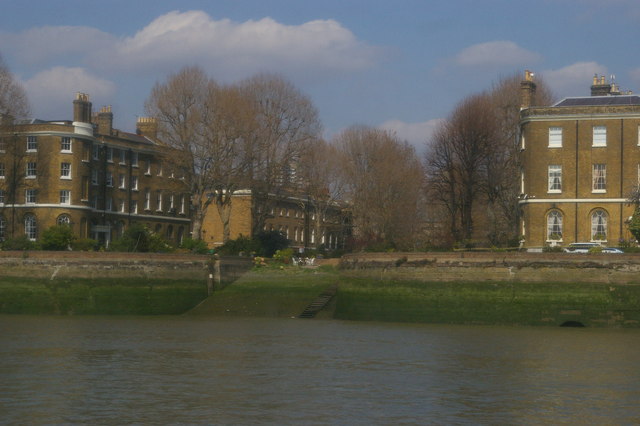
Right you know that middle class thing where you constantly say “ooh I would love to move here” after just about every charming place you’ve ever been to. Well this is my London equivalent. Pier Head in particular is my favourite residential street. Georgian, tick, A bit of bow-fronted action, tick. A sort of square, tick. River frontage, tick. Not entirely surrounded by ponceyness, tick. A wee bit off the beaten track, tick. There is an excellent walk along the river from Canary Wharf to St Katherine’s Dock, on a sunny day with ideal watering holes along the way, but this is the highlight.
3. Chiswick Mall and Hammersmith Terrace, W4

Right the sharp eyed amongst you are going to notice a theme emerging. If it is Queen Anne/Georgian/Regency and on the river and bonkers posh them I am bound to like it. Once again there is a marvellous sunny day walk to be had from Hammersmith Bridge to St Nicholas’s Church in old Chiswick with loads of historical and architectural interest and it is so grand. Especially when the tide is up.
Specifically on this bit is Hammersmith Terrace, 17 Georgian beauties best seen from the river, with multiple literary/publishing associations, Chiswick Mall, and in particular, Said House (the temporary lodgings for Series ! Apprentice “contenders” no less), Bedford House and Walpole House, all with loads of famous past owners, a whiff of the boat building and fishing industries which were here before the toffs moved in, St Nicholas itself where Hogarth is buried and the Fullers Brewery, home of London’s finest beer, and I believe its oldest wisteria.
4. Strand on the Green, W4

Next up in the extraordinarily pretty West London on the river stakes is Strand-on-the-Green. From old Chiswick above, take a skip through Chiswick House, a neo-Palladian beauty, interior now open, with a cracking modernist caff, and in a few minutes you could be in Thames Road and on to the towpath. Bulls Head or City Barge for a pint and a scoff and admire the houses, a range of styles with some quite prosaic in their way. The very essence of picturesque. Over Kew Bridge and into Kew Gardens. Happy days.
5. Waterloo back streets – Theed Steet, Roupell Street, Whittlesey Street. SE1
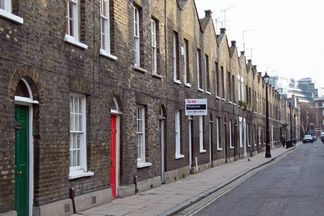
If you nip out of Waterloo down to Waterloo Road, cross over and head down down Sandell Street or Alaska Street then North a few paces (careful there’s Konditor and Cook for a cake on the corner) and you’ll be in Roupell Street. Together with its two terraced neighbours it comes over like a Northern mill village in a Gaskell novel in mid Victorian times. Only without the grime, and the poverty, and the appropriation of labour by evil capitalists in top hats. And now with commuters hurrying through and with well-heeled punters spilling out of the White Hart and the Kings Arms on a Friday night. Oh and these dinky little houses will set you back 2 million quid so more banker than machinist. But it is so pretty.
Talking of little fellas, you know the bit at the beginning of Saturday Night Takeaway when Britain’s premier light entertainment duo Ant and Dec are mopedding along a street – well that was filmed here. That’s how dinky the houses are – even Ant and Dec are in proportion. So next time you are at the National Theatre, Old Vic or Young Vic, (and these together with the Barbican, Almeida, Royal Court, Donmar and Bridge are where the visitor should go for top notch theatre – not the West End), make sure to have a peek if you don’t already know the area.
6. Folgate Street, Fournier Street, Princelet Street, Elder Street, Fleur de Lys Street, Artillery Passage, Artillery Lane – Spitalfields, E1
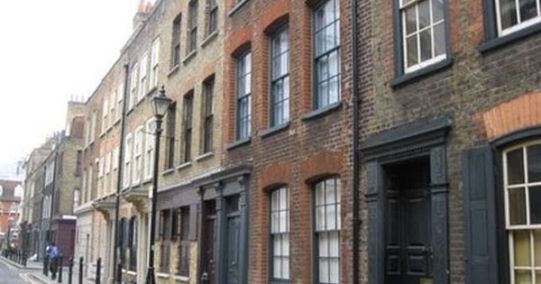
So I cannot choose one street alone in Spitalfields so here is the best of the bunch. Right you kids won’t believe this but I can remember a time when this area was still dodgy. And we used to play 5 a side footie inside the market.
After all the Spitalfields Historic Buildings Trust, beloved saviour of our architectural heritage or devilish promoter of hyper-gentrification,take your pick, was only founded in 1977. And trust me oh bearded ones, before they got to work there was no way you would have been seen in Shoreditch which was even worse.
But the change in the last 30 years ago the change has been off the scale. You all know the story. Fields become a Medieval priory/hospital … then stunning homes (to our eyes if not at the time) for Huguenot silk weavers (and London’s first wave of Irish diaspora) are built – I read someone that a quarter of Londoners come from Huguenot stock but I might have made that up – …. then silk goes down the pan and it turns into a right sh*thole (I have lost count of the number of dodgy “rookeries” in London in the C18) …. until the Jewish immigration of the late C19 begins …. to then be followed in the later C20 by the Bangladeshi community … until finally the creative toffs arrive to “rescue” the buildings.
And once it gets going, blimey it doesn’t stop. So now we have an extraordinarily diverse playground expansing north and east. And for my money, in the streets above, some of the most beautiful houses in the capital.
Anyway you will all know it but next time you’re there take a bit of time to look around and think about the history and all the wonderful people who have lived and worked here. And maybe listen to “We Are London” by Madness whilst you are at it. Off the under-rated The Liberty of Norton Folgate album. Said Liberty of course being right here in Spitalfields. I am mightily pleased with that link.
7. Pond Square, South Grove and The Grove – Highgate N6
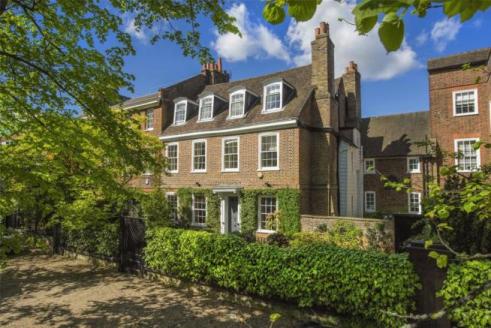
Right now we go properly Heat/Hello/Mail Online celeb sh*te. I wish I could avoid including these renowned Highgate haunts in this list but they are just so lovely. And there is a bit more variation in the housing stock that you might imagine with some tasty modernist inspired stuff on show as well. Anyway no need to bang on here as you all know where it is but if it’s been a while since your last visit I suggest a Sunday morning walk and a spot of lunch.
Crammed with history and views, the rich and famous of Highgate have been stopping it getting f*cked up by planners and developers basically from the Georgian off. If you are canny and take a view on a falling London luxury property market you might get a bargain, semi with change from 10 million quid.
Down the road the Cemetery is always worth a look (the final resting place of Britain’s greatest author – guess who?) but not a patch on its peers at Abney Park (properly Gothic at dusk) or Kensal Green. If you come from the tube be sure to take in Highpoint, Lubetkin’s modernist masterpiece, and if you start going down the Highgate West Hill you will hit the monstrosity that is Witanhurst. Look it up.
8. Rotherhithe Street, SE16
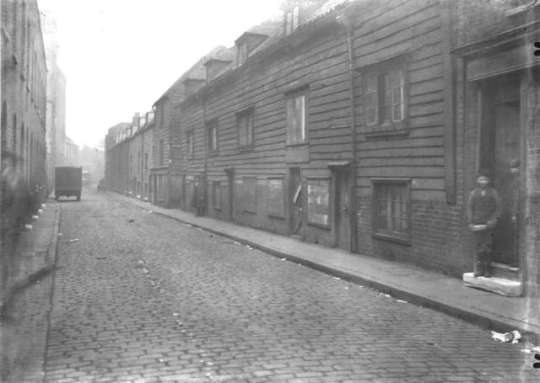
I think this is London’s longest street at the thick end of 2 miles. And it’s a belter. If you haven’t walked along it then do so a.s.a.p. It can, for the most part, be fairly quiet allowing you to properly soak up the atmosphere (to set the scene I have inserted a photo from the 1930s with a bona fide street urchin). Whilst you may not always be right on the river for some of it, you will always be conscious of its presence and therefore of London’s maritime past. Which reminds me, if you have never been to London Museum of Docklands (no shame in that), then get off there immediately. No river, no city simple as that. Makes you wonder why for so long London turned its back on its river (though I guess if it stank and you died falling in perhaps it did make sense in them olden days).
Anyway this street like no other tells the watery story. Obviously when it was called Redcliffe in the heyday C17/18/19 it was another candidate for worst rookery in London. And just as obviously, by the late C20, it had become a stomping ground for the rich, at least the western end. The Mayflower pub, St Mary’s Church Brunel’s Engine House, all together create a perfect period drama location. Indeed, as if to ram it home, there is a production company right here that caters for just that. But the real fun starts as you go east round the bend with the views across the river to Wapping, Shadwell and Canary Wharf, and with the extraordinary range of buildings on this side of the river, some lovely, some interesting and some awful. But mostly sympathetic to the river, in stark contrast to the Vauxhall to Putney riverside developments.
Rotherhithe Street Peters out by Surrey Docks Farm. No need for you to do so though. Keep walking, as close to the river as you can. Deptford, Greenwich, the O2, Thames Barrier, Woolwich, Thamesmead, Crossness Pumping Station (a Victorian marvel), Erith and all the industrial past and present of the other side of London. Not pretty but fascinating nonetheless.
9. Grove Terrace – Kentish Town, NW5
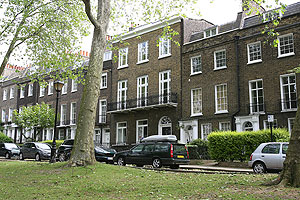
This really is a gem. A row of exquisite Georgian houses opposite the entrance to Parliament Hill on the Tufnell Park/Kentish Town side. But unlike some of the other Georgian streets on the list it is not entirely surrounded by chi-chi stuff though it is still “eminently desirable”. Go see. And trot up to Parliament Hill which all residents/visitors in London should see 4 times a year in each of the seasons or risk being booted out to the sticks. (No prizes for guessing my favourite view in London).
10. Montpelier Row, Orleans Road, Riverside and Sion Road – Twickenham, TW1
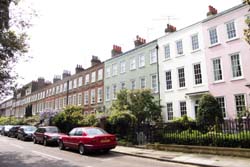
Last on the current list but I still adore it. Another early Georgian terrace but this time of very substantial houses, flat-fronted, in perfect proportion, looking over the jewel that is Marble Hill House and within spitting distance of the river once again. And next door Orleans Road is the servants equivalent as it were, with Sion Road a few hundred yards to the West, another cracking Georgian terrace. Of course the Elysian fields of Richmond, St Margarets, Twickenham and Strawberry Hill have always been a toffs paradise but there is something specifically about this row that I love. It could just be familiarity of course.
So if you are one of the East End youngsters who thinks you need a passport for Zone 6, get off your high horse, front up to your mates and take them to the Swan on the river at Twickenham for a pint or Spritz or whatever you drink now, and then trot along the river back to Richmond. Or nip round to Strawberry Hill House, the extraordinary creation of the delightfully flamboyant Horace Walpole. Or up the road to Mr Turner’s little country cottage (as it was). JMW is without doubt another Top 10 Londoner. Or across the river on the foot ferry to Ham House, the best early C17 house in the Western world – I kid you not.
So that’s your lot. Well maybe not quite. Of course I have many more candidates and I just love lists so here is what is bubbling under, in a vaguely geographical way. When I get round to it I better say why I like these too but right now I need a cup of tea.
Toodle pip.
- King’s Bench Walk – Inner Temple, EC4
- Ely Place – Holborn, EC1
- John Adam Street WC2
- Frith St and Greek St – Soho, W1
- South Moulton St – Mayfair W1
- Wilton Row and Old Barrack Yard – Belgravia, SW1
- Kensington Palace Gardens, W8
- Melbury Road – Holland Park, W14
- Cheyne Walk – Chelsea, SW6
- Flash and Well Walks – Hampstead NW3
- Alwynne Villas – Islington, N1
- Stepney Green East side, E1
- Mile End Place, E1
- Paradise Row – Bethnal Green, E2
- Albury St – Deptford, SE8
- Ballast Quay – Greenwich SE10

A belter of a post! Great, Thank you!
LikeLike
Thanks. I see you went to the Design Museum recently. Love the building. At the risk of sounding like a pensioner I wondered if you had an Art Pass – makes getting in to things like that a bit cheaper and pays for itself.
Cheers
LikeLiked by 1 person
No I don’t know about the Art Pass. I will look it up. Cheers!
LikeLike